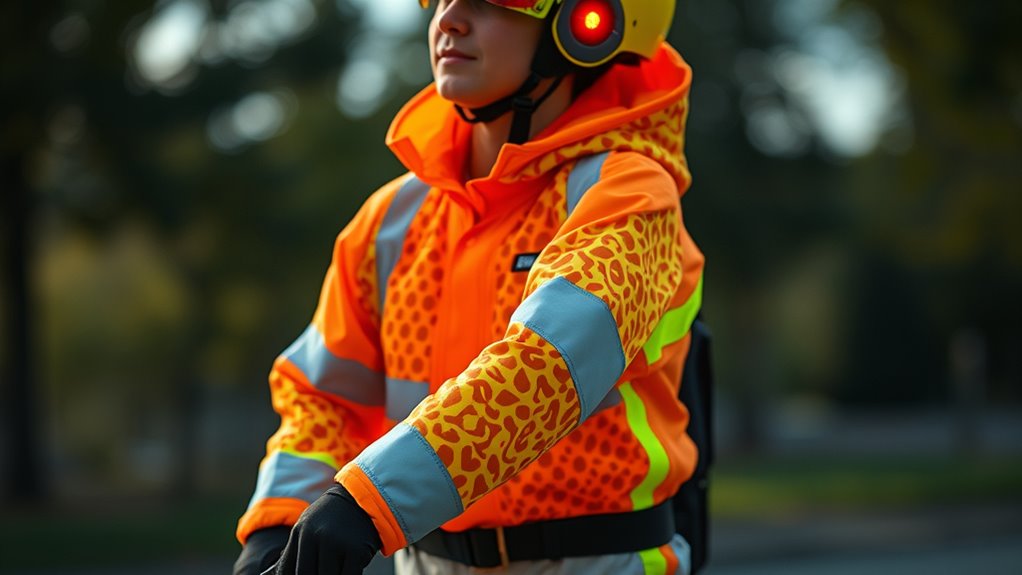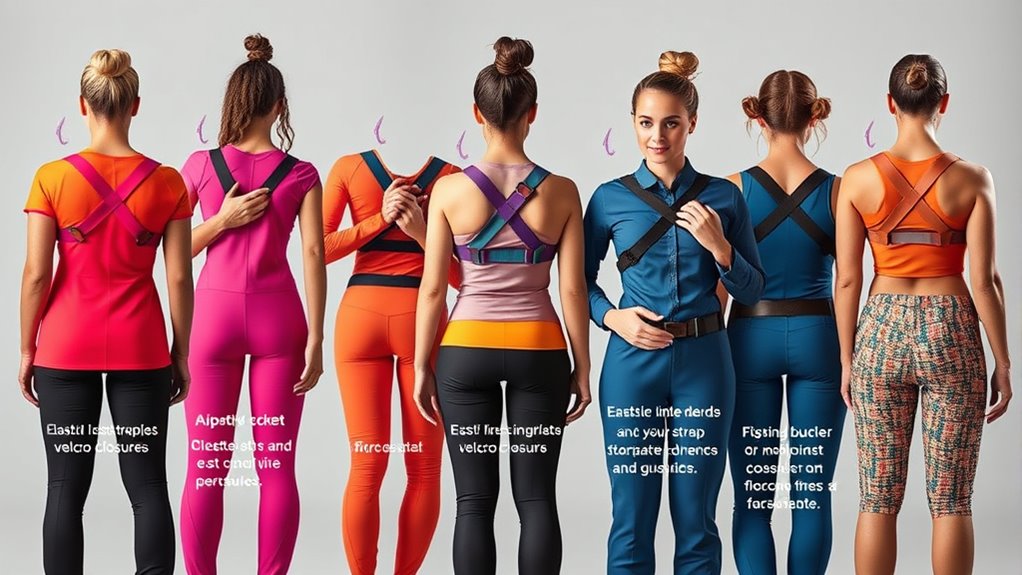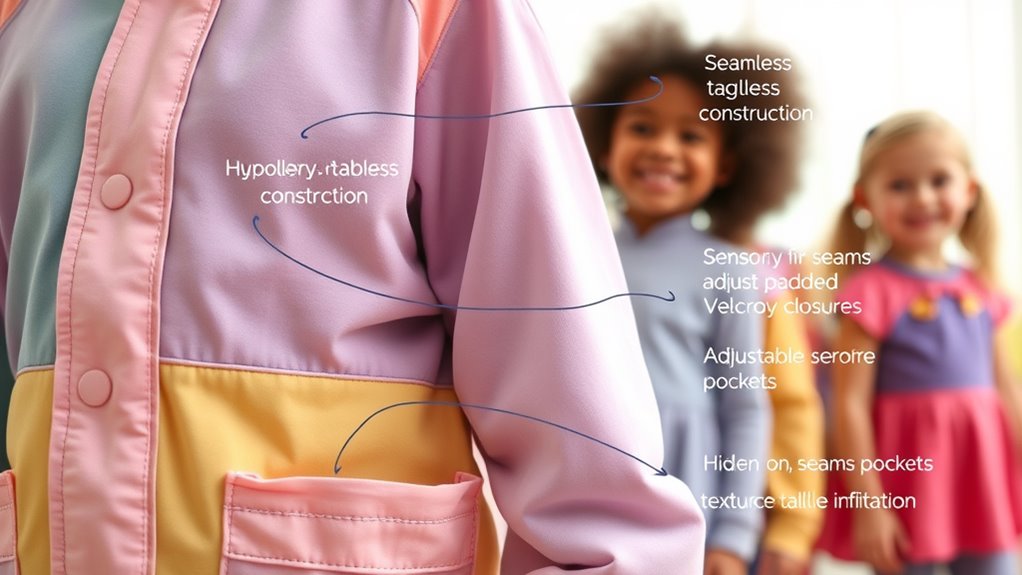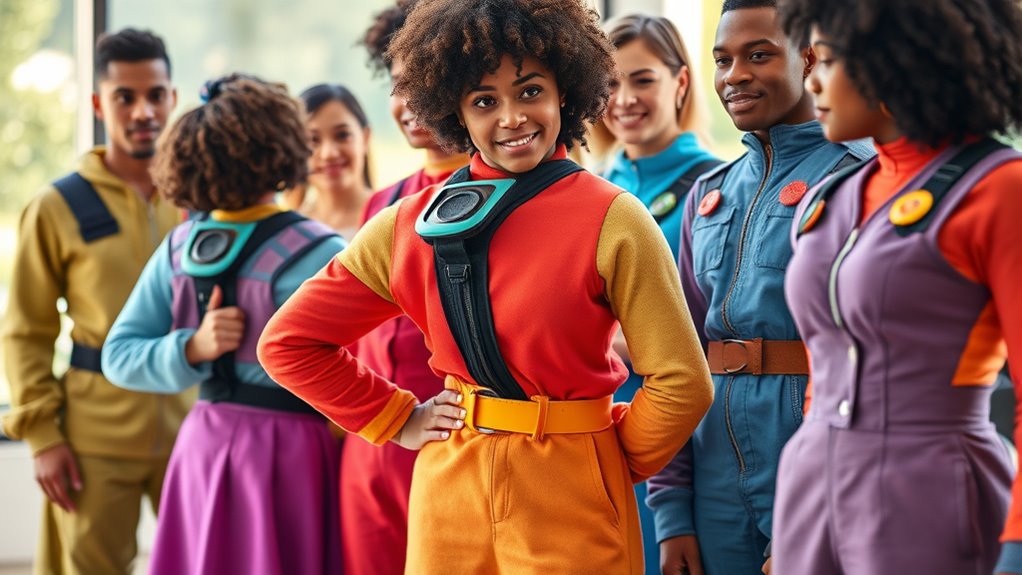To create adaptive costumes that are accessible, choose lightweight, breathable fabrics and incorporate simple fasteners like magnets, Velcro, or snap buttons for easy dressing. Prioritize visibility with bright colors, contrasting shades, and reflective materials to enhance safety. Use adjustable features such as straps and elastic panels for a customizable fit. Add versatile, modular components and sensory-friendly touches to support different abilities. Keep maintenance simple with durable, washable materials. Explore these ideas to make inclusive costumes that everyone can enjoy.
Key Takeaways
- Use lightweight, breathable fabrics combined with adaptive closures like magnetic fasteners and Velcro for easy, comfortable dressing.
- Incorporate high-contrast colors, reflective materials, and modular components to enhance visibility and safety in various environments.
- Design with adjustable straps, elastic panels, and sensory-friendly features such as tagless labels and removable accessories for inclusivity.
- Opt for durable, weather-resistant fabrics and reinforce stress points to ensure longevity and ease of maintenance.
- Include flexible design elements, creative accessories, and customizable modular parts to foster personalization and creative expression.
Choosing Lightweight and Breathable Fabrics for Comfort

When selecting costumes, prioritizing lightweight and breathable fabrics can substantially enhance your comfort. Fabric breathability is key because it allows air to flow, preventing overheating and moisture buildup. Opt for materials like cotton, linen, or moisture-wicking blends that promote airflow and keep you feeling cool. These fabrics also reduce the overall costume weight, making it easier to wear for extended periods without fatigue. Heavier fabrics can restrict movement and cause discomfort, especially during active moments. Choosing lighter fabrics ensures your costume remains comfortable and practical, whether you’re attending a convention, parade, or celebration. Remember, the goal is to stay comfortable and avoid overheating, so always consider fabric breathability and costume weight when selecting your adaptive costume.
Incorporating Adaptive Closures for Easy Dressing

Adaptive costumes often feature closures that make dressing simpler and quicker. Magnetic fasteners, Velcro straps, and snap buttons all provide easy options for secure yet accessible fastening. By choosing the right closures, you can guarantee comfort and independence for anyone wearing the costume. Considering tuning modifications can also inspire innovative ideas for adjustable closures and enhanced functionality.
Magnetic Fasteners Ease Use
Magnetic fasteners have revolutionized adaptive costumes by making dressing quicker and less frustrating. They provide a secure hold while allowing for effortless closure, which considerably improves ease of use. Unlike traditional buttons or zippers, magnetic fasteners click into place smoothly, reducing the need for fine motor skills or precise alignment. This makes dressing easier for individuals with limited dexterity or strength. You’ll find magnetic fasteners work well on shirts, jackets, and accessories, offering a seamless solution that minimizes discomfort and fuss. Their simple mechanism helps you get ready faster, boosting confidence and independence. Additionally, magnetic fasteners can be designed to incorporate safety features, ensuring they are both effective and secure for everyday use. Overall, incorporating magnetic fasteners into your wardrobe ensures a practical, accessible approach to dressing that prioritizes comfort and simplicity without sacrificing style.
Velcro Straps Adjust Quickly
Velcro straps adjust quickly, making dressing simpler and more efficient. With velcro straps, you don’t need to struggle with buttons or zippers; instead, you can easily secure or loosen the costume with a quick pull or press. This feature allows for quick adjustments, saving time and reducing frustration during dressing. Velcro straps are especially helpful for individuals with limited dexterity or mobility challenges, as they require minimal fine motor skills. You can customize the fit easily, ensuring comfort and safety. Plus, velcro’s reliability means the costume stays secure once fastened, yet can be adjusted effortlessly if needed. Incorporating velcro straps into adaptive costumes streamlines the dressing process and enhances independence for the wearer. Additionally, high contrast ratios in projectors improve visual clarity, making the details of the costume design more vivid and easier to see.
Snap Buttons Simplify Dressing
Snap buttons offer a straightforward way to simplify dressing, especially for those with limited dexterity or mobility challenges. Unlike traditional buttons and zippers, snap buttons are easy to open and close with minimal effort, increasing dressing ease. They are durable and secure, reducing frustration and the need for assistance. You can replace tricky fasteners on shirts, pants, or costumes with snap buttons, making dressing quicker and more independent. Their simple design also helps caregivers and family members assist more efficiently. Installing snap buttons is a cost-effective, accessible solution that enhances comfort and independence. Incorporating adaptive clothing features like snap buttons into adaptive costumes can significantly improve the dressing experience for individuals with various needs.
Designing for Visibility and Safety in Costumes

Designing costumes with visibility and safety in mind is essential to guarantee wearers are easily seen and protected in various environments. You can achieve this by incorporating strong visual contrast between the costume and its surroundings, making it stand out clearly. Using reflective materials is also vital, especially in low-light or nighttime settings, as they bounce back light and draw attention. Bright colors combined with reflective strips ensure maximum visibility for pedestrians, cyclists, or performers. Avoid dark or muted tones in high-risk areas. Keep safety features simple but effective, like strategically placed reflective patches or strips on arms, legs, or the back. Additionally, selecting appropriate material choices that are durable and weather-resistant can enhance both safety and longevity of the costume. By prioritizing these elements, you help ensure wearers remain visible and safe, regardless of the environment or time of day.
Using Adjustable Elements to Accommodate Different Sizes

To guarantee costumes fit a variety of body sizes comfortably and securely, incorporating adjustable elements is essential. Adjustable straps allow you to customize the fit, ensuring comfort without sacrificing style. These straps can be easily lengthened or shortened, accommodating different torso lengths or shoulder widths. Using size flexible designs, such as elastic panels or drawstrings, further enhances adaptability. These features enable the costume to expand or contract as needed, providing a snug fit for various body shapes. Incorporating adjustable elements not only improves comfort but also increases the costume’s versatility, making it suitable for different wearers. By focusing on adjustable straps and flexible designs, you create costumes that are inclusive, functional, and easy to wear for everyone. Additionally, selecting materials with diverse designs can further enhance the costume’s appeal and adaptability.
Creating Versatile Costumes for Multiple Abilities

Using adaptive fastening techniques and modular components, you can design costumes that easily accommodate various abilities. These methods allow quick adjustments, making the costume more functional for different needs. By focusing on versatility, you guarantee your costume works seamlessly across multiple scenarios. Incorporating regional flavors and traditions can enrich the costume’s cultural authenticity, enhancing its regional culinary arts appeal.
Adaptive Fastening Techniques
Adaptive fastening techniques are essential for creating costumes that can easily accommodate a range of abilities. By choosing adjustable or easy-to-manipulate fasteners, you guarantee the costume remains secure yet accessible. Hook-and-loop fasteners, magnetic snaps, and large, easy-open buttons are excellent options that support quick adjustments and ease of use. These techniques also enhance costume durability, preventing wear and tear from frequent handling. When selecting fasteners, consider how often the costume will be worn and how much stress it will endure. Properly integrated adaptive fastening techniques not only improve functionality but also make the costume more versatile for different users. Additionally, understanding affiliate disclosures can help you make informed choices about sourcing materials, ensuring transparency and compliance. This approach ensures the costume remains comfortable, safe, and long-lasting across various abilities.
Modular Costume Components
Creating versatile costumes for multiple abilities is best achieved through modular components that can be easily added, removed, or adjusted. This approach allows you to customize costumes quickly, catering to different needs and preferences. Incorporate interactive fabric textures to enhance tactile engagement and provide sensory feedback. Use sustainable material choices to create eco-friendly options that are both durable and comfortable. Modular designs enable quick adaptation for various abilities, making costumes more inclusive. Consider these key points:
- Attachments with magnetic or hook-and-loop fasteners for easy swapping
- Layered sections for adjustable coverage and mobility
- Interchangeable accessories to personalize the look
- Use of sustainable fabrics that maintain durability
- Incorporation of interactive fabric textures for sensory versatility
- Creating adaptable costumes supports ease of modification and personalization for different users.
This method supports adaptability, comfort, and environmental consciousness.
Selecting Color Palettes for Inclusivity and Accessibility

How can you choose color palettes that effectively promote inclusivity and accessibility in costume design? Focus on strong color contrast to ensure visibility for individuals with visual impairments. High contrast between foreground and background colors makes details stand out clearly. Additionally, aim for color harmony to create visually pleasing combinations that aren’t overwhelming. Avoid relying solely on color to convey important information; incorporate patterns or textures to support those with color vision deficiencies. Use tools like color contrast checkers to verify accessibility standards. By thoughtfully selecting your palette, you enhance both the aesthetic appeal and functionality of your costumes, ensuring they’re inclusive for everyone. Incorporating considerations such as electric dirt bike horsepower can inspire innovative, dynamic costume elements that evoke energy and movement. Striking the right balance between contrast and harmony is key to achieving accessible and engaging designs.
Embedding Sensory-Friendly Features Into Costume Design

Embedding sensory-friendly features into costume design requires thoughtful choices that prioritize comfort and ease of wear. Your goal is to support sensory integration while maintaining inclusive aesthetics. Focus on reducing overstimulation by selecting soft, breathable fabrics and avoiding excessive embellishments. Use seamless construction to minimize irritation and ensure the costume feels gentle against the skin. Incorporate adjustable closures for a customized fit, making dressing easier. Consider adding quiet, hidden fasteners instead of loud, bulky ones. Utilizing user-friendly interfaces can help designers incorporate these features more effectively. Use calming, muted color schemes. Opt for tagless labels or smooth seams. Include removable sensory-friendly accessories. Design with simple, non-restrictive shapes. Prioritize lightweight, breathable materials. These elements help create costumes that are comfortable, inclusive, and supportive of sensory needs.
Utilizing Modular Components for Customization

Modular components offer a versatile way to customize costumes to fit individual preferences and needs. By incorporating interchangeable parts, you can easily adapt the costume’s appearance, comfort, and functionality. This flexibility expands your customization options, allowing for quick modifications without starting from scratch. For example, you might swap out different sleeves, accessories, or fasteners to suit different occasions or comfort levels. To help visualize this, here’s a simple comparison:
| Component Type | Customization Options |
|---|---|
| Sleeves | Short, long, or detachable |
| Fasteners | Velcro, snaps, or magnetic closures |
| Accessories | Decorative patches, badges, or embellishments |
| Padding | Soft inserts for comfort or shape |
| Closures | Zippers, buttons, or hook-and-loop fasteners |
Using modular components simplifies personalization and boosts your costume’s adaptability, especially when considering costume durability and longevity.
Ensuring Ease of Maintenance and Durability

To guarantee your costume remains functional and looking great over time, focus on designing for ease of maintenance and durability from the start. Prioritize materials that withstand frequent wear and washing, and choose fabrics that are easy to clean. Establish clear cleaning protocols to prevent damage and promote costume preservation. Regular inspections help identify weak points before they worsen. Incorporate removable or washable components for quick updates. Use reinforced stitching at stress points to extend lifespan. When selecting fasteners, opt for durable options that won’t easily break. Additionally, selecting appropriate materials that resist wear and tear can significantly enhance the costume’s longevity.
Inspiring Creativity With Inclusive Accessories

Inspiring creativity with inclusive accessories invites everyone to express their unique identity and imagination. By incorporating creative patterning, you can transform simple accessories into personal statements that showcase individuality. Use vibrant colors, diverse textures, and playful designs to spark inspiration and encourage self-expression. Cultural symbolism adds depth and meaning, allowing wearers to connect with their heritage or explore new cultural stories. These accessories become more than decorative; they serve as conversation starters and confidence boosters. When designing inclusive accessories, focus on versatility and open-ended possibilities. This approach empowers users to mix, match, and personalize pieces to reflect their personality and creativity. Embracing adaptive design principles ensures that accessories are accessible to people with diverse needs, fostering inclusivity. Ultimately, inclusive accessories celebrate diversity and foster a sense of belonging through thoughtful, expressive design.
Frequently Asked Questions
How Can Adaptive Costumes Be Made More Affordable for Families?
You can make adaptive costumes more affordable by supporting cost-effective manufacturing methods, which reduce production costs and lower prices. Additionally, participating in or establishing community sewing programs allows families to access handmade costumes at a lower cost. These programs foster collaboration, share resources, and build skills, making adaptive costumes more accessible and budget-friendly for everyone. This approach helps guarantee that all children can enjoy fun, functional costumes without financial strain.
Are There Specific Materials Recommended for Allergy-Sensitive Costume Design?
You’ll want to choose hypoallergenic fabrics and non-toxic materials for allergy-sensitive costume design. These fabrics, like organic cotton, bamboo, and silk, reduce irritation and are safe for sensitive skin. Since many costumes are made of synthetic materials, always check labels and opt for natural, chemical-free options. You might find that blending comfort with safety becomes easier when you prioritize these materials, ensuring everyone can enjoy costumes without worry.
How Do Adaptive Costumes Accommodate Extreme Temperature Changes?
You can accommodate extreme temperature changes in adaptive costumes by integrating thermal insulation to keep wearers warm or cool, depending on the environment. Use moisture control fabrics to wick away sweat and prevent overheating or chilling. Adding removable layers or adjustable features allows for quick adaptation to temperature shifts. This approach guarantees comfort and safety, making the costume functional across various weather conditions without sacrificing accessibility or style.
Can Adaptive Costumes Be Easily Altered for Different Events or Themes?
Yes, you can easily alter adaptive costumes for different events or themes by incorporating modular accessories and quick change features. You just detach or swap out specific parts, like sleeves, hats, or embellishments, to match the new look. This makes costume transformation simple and efficient, saving you time and effort. With these adaptable design elements, you can customize your costume for any occasion without needing extensive modifications.
What Training Is Needed for Costume Designers to Create Inclusive Designs?
You need training in universal design principles and inclusive fashion to create truly accessible costumes. This includes understanding diverse needs, such as mobility, sensory, and cognitive differences, and how to incorporate adaptive features seamlessly. By learning these skills, you can design costumes that are functional, comfortable, and stylish for everyone. Getting familiar with accessible materials and adaptive techniques guarantees your designs promote inclusivity and meet various user needs effectively.
Conclusion
By blending breathable fabrics, bold closures, and customizable components, you create costumes that are both comfortable and mesmerizing. Prioritize safety, sensory-friendly features, and versatility to craft inclusive looks that inspire imagination. With thoughtful touches and easy-to-maintain designs, you empower everyone to participate and play. Remember, with adaptable accessories and innovative ideas, your costume creations can confidently cater to all, making every dress-up a delightful, dynamic, and memorable masterpiece.










